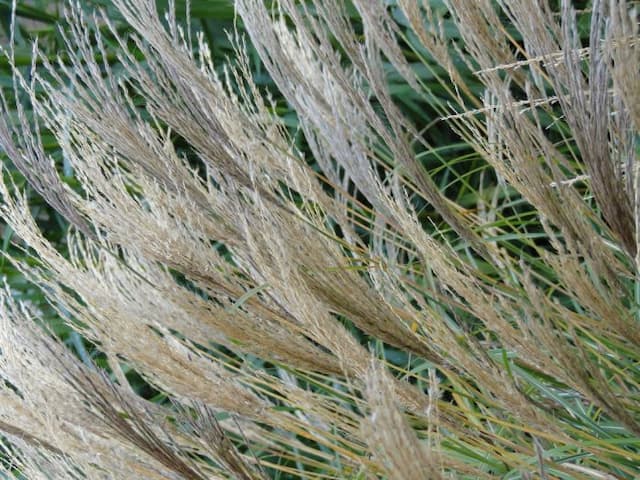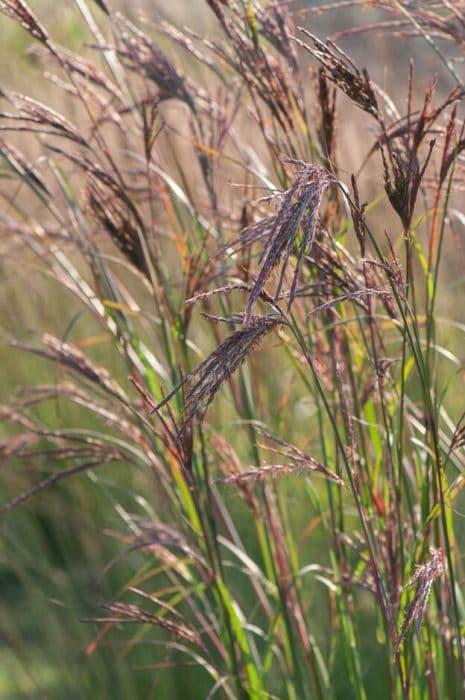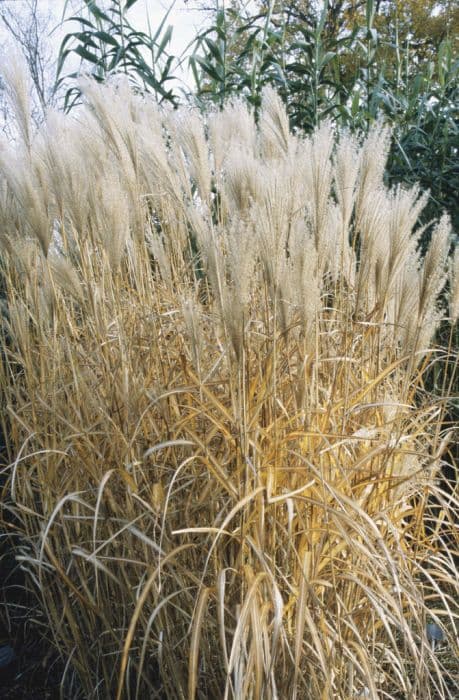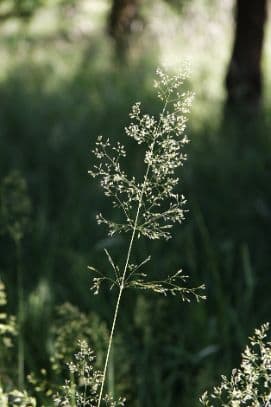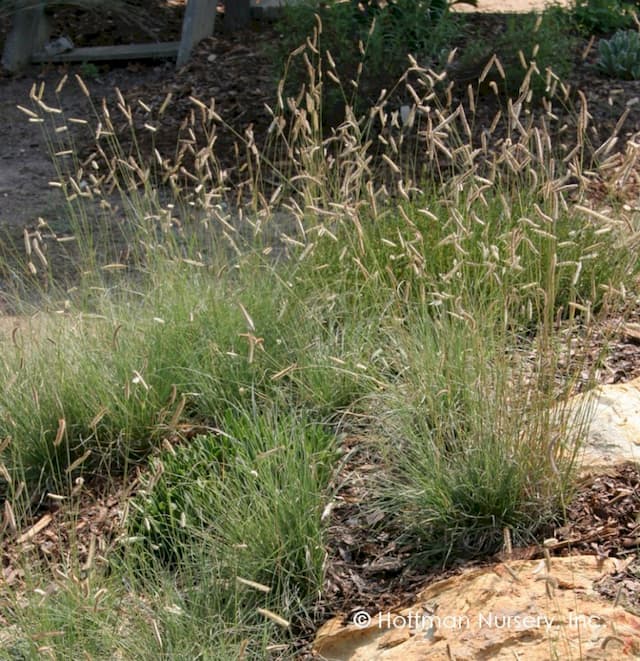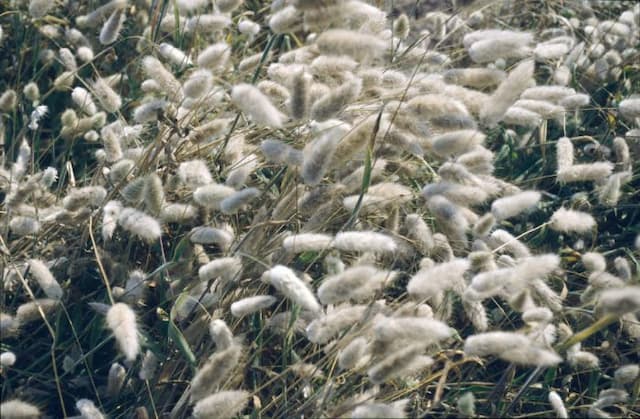Bitter panicgrass Panicum amarum 'Dewey Blue'

ABOUT
The plant known as 'Dewey Blue' is a grass with an appealing sea of steel blue foliage that forms dense mounds or clumps. The leaves are long, narrow, and arch elegantly, swaying gracefully with the breeze. During the warmer months, the foliage provides a lovely bluish-gray color that serves as a striking contrast to the greener plants in garden settings. This ornamental grass blooms with tall, airy panicles that emerge above the foliage, bearing flower spikes with a delicate, feathery appearance. The blooms can give the plant a hazy, soft texture as they mature, often lightening to a silvery-white tone. The overall form of the grass is upright yet flowing, creating a sense of movement and texture in the landscape. It is hardy and drought-resistant, often used in coastal areas where its resilience to salt and winds is highly valued.
About this plant
 Names
NamesFamily
Poaceae
Synonyms
Dewey Blue Bitter Panicgrass, Bitter Switchgrass
Common names
Panicum amarulum, Panicum amarum var. amarulum.
 Toxicity
ToxicityTo humans
Bitter panicgrass is not commonly known to be toxic to humans. There are no well-documented cases of poisoning, and it is generally considered safe with no significant toxic effects reported. Therefore, inadvertently ingesting parts of the Bitter panicgrass plant is not expected to cause harm or poisoning symptoms in humans.
To pets
Bitter panicgrass is also not commonly known to be toxic to pets. Like in humans, there is no significant evidence to suggest that ingestion of this plant by animals such as dogs or cats would be harmful. It is not listed among the common poisonous plants for pets, and no specific symptoms of poisoning from Bitter panicgrass are recognized in veterinary literature.
 Characteristics
CharacteristicsLife cycle
Perennials
Foliage type
Deciduous
Color of leaves
Blue-green
Flower color
Varies
Height
4-6 feet (1.2-1.8 meters)
Spread
2-3 feet (0.6-0.9 meters)
Plant type
Grass
Hardiness zones
4-9
Native area
North America
Benefits
 General Benefits
General Benefits- Erosion control: The root system of Panicum amarum 'Dewey Blue', commonly known as bitter panicgrass, helps stabilize soil and prevent erosion on slopes and dunes.
- Drought tolerance: Bitter panicgrass is highly tolerant of dry conditions, making it suitable for xeriscaping and low-water landscapes.
- Beachfront landscaping: With its native habitat being coastal regions, it is ideal for beach and seaside landscaping, where it withstands salt spray and sandy soils.
- Wildlife habitat: It provides food and shelter for birds and other wildlife, contributing to the local ecosystem.
- Low maintenance: Bitter panicgrass requires minimal care once established, reducing the need for fertilizers, pesticides, and frequent watering.
- Aesthetic appeal: Its blue-green foliage and airy seed heads add texture and movement to gardens, enhancing visual interest throughout the seasons.
- Soil improvement: As a native grass, it contributes to the organic matter in the soil, gradually improving soil health and structure.
- Windbreak: Its growth can act as a natural windbreak, protecting smaller plants and reducing wind erosion.
- Adaptability: This plant adapts well to a range of soil types, from well-draining sandy soils to heavier clay soils.
- Fire resistance: Being a grass native to open areas, it is also adapted to occasional fires, which can be an asset in fire-prone regions.
 Medical Properties
Medical PropertiesThis plant is not used for medical purposes.
 Air-purifying Qualities
Air-purifying QualitiesThis plant is not specifically known for air purifying qualities.
 Other Uses
Other Uses- Panicum amarum 'Dewey Blue', commonly known as bitter panicgrass, can be used to stabilize soil in coastal areas due to its extensive root system, which helps prevent erosion.
- In landscape design, it can serve as a natural barrier or screen, providing privacy while adding ornamental value with its bluish-green foliage and airy flower spikes.
- It can be planted in wildlife gardens to provide shelter and potential nesting sites for birds and small mammals.
- As a component of a rain garden, bitter panicgrass can tolerate occasional flooding and can help manage stormwater runoff.
- In large-scale reclamation projects, such as post-mining site restoration, it can be an effective pioneer plant that prepares the soil for other species to colonize.
- Used in educational settings, such as school gardens or environmental studies programs, it can help teach about native plant conservation and dune ecology.
- It can be used as a forage plant for grazing livestock, although it may not be the most palatable choice compared to other forages.
- Bitter panicgrass can serve as a windbreak in agricultural fields, reducing wind erosion and protecting crops.
- The inflorescences can be used in dried floral arrangements for a rustic or coastal-themed decor.
- In large public parks or natural reserves, it can create natural paths and borders that blend in with the environment and require minimal maintenance.
Interesting Facts
 Feng Shui
Feng ShuiThe Bitter Panicgrass is not used in Feng Shui practice.
 Zodiac Sign Compitability
Zodiac Sign CompitabilityThe Bitter Panicgrass is not used in astrology practice.
 Plant Symbolism
Plant Symbolism- Strength and Resilience: 'Dewey Blue' is known for its robust nature and ability to withstand harsh coastal environments, symbolizing an individual's strength and resilience in the face of adversity.
- Flexibility: As a plant that sways with the wind without breaking, 'Dewey Blue' represents the ability to adapt and be flexible in life.
- Protection: It often forms a natural barrier against beach erosion, representing protection and a safeguarding presence.
- Healing: Associated with its natural habitat, 'Dewey Blue' is symbolic of healing qualities, referencing the restorative nature of the sea and open spaces.
 Water
WaterBitter Panicgrass, commonly known as 'Dewey Blue', requires moderate watering. During the growing season, water the grass deeply once a week, providing about one inch of water or roughly 0.6 gallons per square yard each time. During periods of drought or extreme heat, increase the frequency to twice a week. Overhead irrigation in the morning is ideal to allow foliage to dry out during the day, reducing the risk of fungal diseases. In the fall and winter, reduce watering as the plant goes dormant and requires less moisture.
 Light
LightBitter Panicgrass thrives in full sun conditions, meaning it should receive at least six hours of direct sunlight daily. The ideal spot for 'Dewey Blue' is an open area free from shade or shadow from structures or larger plants, ensuring it gets uninterrupted sunlight throughout the day.
 Temperature
TemperatureBitter Panicgrass prefers a temperate climate, performing best in temperatures between 60°F and 75°F. It can withstand colder temperatures down to 20°F but may not survive prolonged exposure to temperatures below this range. It's important to plant 'Dewey Blue' in a location where temperatures do not frequently drop below freezing.
 Pruning
PruningPruning Bitter Panicgrass is necessary to maintain its shape and encourage new growth. Cut back the grass in late winter or early spring before new growth starts, removing dead foliage and shaping the plant. Prune about one-third of the plant's height to stimulate fresh, healthy shoots. The best time for pruning 'Dewey Blue' is just as the frost threat has passed.
 Cleaning
CleaningAs needed
 Soil
SoilBitter Panicgrass 'Dewey Blue' prefers well-draining sandy soil with medium moisture levels. The ideal soil pH should range between 5.0 and 7.0. For best results, create a mix with sand, loamy garden soil, and organic compost to provide nutrients and improve drainage.
 Repotting
RepottingBitter Panicgrass 'Dewey Blue' typically does not require frequent repotting. This grass thrives outdoors and only needs repotting if it outgrows its container, which might occur every 2-3 years. When repotting, use a fresh soil mix that matches the ideal soil conditions.
 Humidity & Misting
Humidity & MistingBitter Panicgrass 'Dewey Blue' is tolerant of a wide range of humidity levels and typically does well in average outdoor humidity. There is no specific humidity requirement for this plant, making it adaptable to various outdoor environments.
 Suitable locations
Suitable locationsIndoor
Grow Bitter Panicgrass 'Dewey Blue' in a sunny spot with a large container.
Outdoor
Place Bitter Panicgrass 'Dewey Blue' in full sun and well-draining soil.
Hardiness zone
4-9 USDA
 Life cycle
Life cycleThe life of 'Dewey Blue' bitter panicgrass begins with seed germination, which occurs when soil temperatures and moisture levels are suitable, generally in late spring or early summer. Seedlings emerge and establish a root system while producing initial blades of grass. As the plant matures, it develops a strong, spreading rhizome structure that allows for vegetative propagation and clonal growth, contributing to its hardy nature. Throughout the growing season, 'Dewey Blue' bitter panicgrass produces tall, flowering culms that can reach several feet in height, with airy panicles appearing in mid to late summer. Pollination occurs via wind, and if fertilization is successful, seeds form and are eventually dispersed near the parent plant or further afield by wind or wildlife. The plant enters a period of dormancy during the winter months, with above-ground growth dying back, while the rhizomes survive underground to resprout the following spring.
 Propogation
PropogationPropogation time
Spring to early summer
Propogation: The most popular method of propagating 'Dewey Blue' bluestem, also known as Dewey Blue bitter panicgrass, is through division. This process typically takes place in late winter to early spring, when the plant is still dormant or just beginning to grow again. You start by digging up an established clump of the grass and carefully separating it into smaller sections, making sure that each new section has a portion of the root system attached. The divisions are then replanted in well-prepared soil, spaced approximately 18 to 24 inches apart (45 to 60 centimeters) to allow for ample growth. It's important to water the new plantings thoroughly to help establish them. Division ensures that the new plants will be true to the characteristics of the parent plant, maintaining the desirable traits of the 'Dewey Blue' variety.

